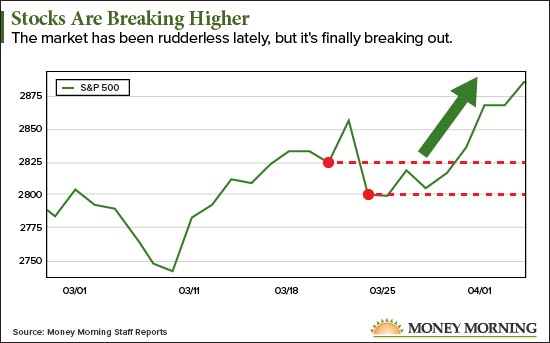Perma-bears were out in full force last week when the yield curve partially inverted, signaling a pending recession. That turned into quite a buying opportunity for investors smart enough not to drink the Kool-Aid.
The yield curve is simply a measure of interest rates from short-term Treasury bills to long-term Treasury bonds. The "inversion" they feared was simply due to the three-month rate moving above the 10-year rate.
And here we are a week later, and that deadly inversion is gone. Baron Rothschild was right - buy when there is blood in streets!
To be sure, the yield curve is not exactly at its healthiest alignment, but even if the two-year yield rises above the 10-year yield, a recession won't happen immediately.
True to form, our experts did not panic. Money Morning Quantitative Specialist Chris Johnson didn't take the bait. He dug into the technical indicators in the S&P 500 and predicted a breakout higher was coming just as the media was hyperventilating over recession fears.
And a breakout is exactly what happened.
Take a look at the chart Chris zoned in on. As you can see, he found the resistance levels (the red lines) that were keeping stocks boxed in throughout March. And he knew that meant the surge above the upper resistance was just a matter of time.

Chris nailed the breakout, but he wasn't looking at just the chart. He looked at many conditions in the market, including a healthy change in leadership. Small-cap, housing, and semiconductor stocks reigned supreme in February as they moved higher. But now, the market is being led by utilities, consumer staples, and real estate.
This Could Be the Most Profitable Dollar You Ever Spend: Tom Gentile's Cash Course covers all the essential trading ideas you need to know to potentially make thousands in extra income every week. Get access for $1...
Not to be left behind, the transportation sector just woke up, too. After more than a year of lagging behind the market, the Dow Jones Transportation Average finally sparked to life.
Chris is looking for big, powerful catalysts to keep the good times rolling. The Mueller report is behind us, China seems to be more willing to talk, and any news coming from Brexit will be better than what we've already seen. Earnings are expected to be pretty good.
But those good times do not have to last for months for us to make some big money on short-term trades. In fact, if the S&P 500 only gets back to last year's highs, we should be able to do some nice business. That's why we are looking at using the power of options to capitalize on the current market's bullishness.
Today, we're going to show you exactly how to turn this stock surge into major profits...
How to Turn This Breakout into Big Profits
[mmpazkzone name="in-story" network="9794" site="307044" id="137008" type="4"]
One of our favorite trades is called a long call spread, and it actually lets the market partially pay for the trade. Sounds too good to be true, but it is the real deal that thousands of options traders use each day.
The catch is that limiting our risk caps the potential profit. But when we are talking about triple-digit gains, it's OK to let the market keep a little bit as an insurance policy.
Here's how it works. With the S&P 500 closing at 2,867.24 Tuesday, we can buy the May 24 $2,860 call for $56.31. That's not cheap, coming in at over $5,000 a contract. But we're not through.
Now, if we simultaneously sell the May 24 $2,950 for $21.59, we collect $2,159 per contract. Subtract that credit from the cost to buy the first options for a net cost of $3,472 for the pair (called a spread).
That cuts the cost of the trade while still giving us plenty of upside to work with.
If we're right and the S&P 500 keeps moving higher, we can potentially collect $9,000 for the spread. That is the difference between the strike prices of the two options - ($2,950 minus $2,860) times $100 per contract.
Subtract the $3,472 cost for a profit of $5,528, before commissions. That is a gain of 159.2%.
Now let's say everything goes wrong and the market tanks. Your long option will lose money, but you also have a short option, which will increase in value. The most you can lose is the net cost of the trade. And don't forget, the spread cost was much less than the cost of just buying a long call option.
With the spread, we limited risk but still had the opportunity to knock one out of the park.
You Can Learn How to Trade Like the Pros - for Just $1
America's No. 1 Pattern Trader, Tom Gentile, is giving you a rare opportunity to learn how to amass a constant stream of extra cash - year in and year out.
And he's going to teach you how to do it entirely on your own.
People have paid up to $30,000 to access his secrets... but it can all be yours for only $1.
Go here to claim your seat in America's No. 1 Pattern Trader Cash Course...


